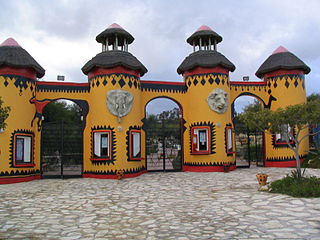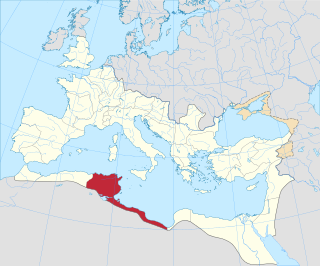
Alexandria is the second-largest city in Egypt and a major economic centre, extending about 32 km (20 mi) along the coast of the Mediterranean Sea in the north central part of the country. Its low elevation on the Nile delta makes it highly vulnerable to rising sea levels. Alexandria is an important industrial center because of its natural gas and oil pipelines from Suez. Alexandria is also a popular tourist destination.

Lumbinī is a Buddhist pilgrimage site in the Rupandehi District of Province No. 5 in Nepal. It is the place where, according to Buddhist tradition, Queen Mahamayadevi gave birth to Siddhartha Gautama in 563 BCE. Gautama, who achieved Enlightenment some time around 528 BCE, became the Buddha and founded Buddhism. Lumbini is one of many magnets for pilgrimage that sprang up in places pivotal to the life of the Buddha.
Río Bec is a Pre-Columbian Maya archaeological site located in what is now southern portion of the Mexican state of Campeche. The name also refers to an architectural style that first appeared at Río Bec and subsequently spread to other nearby sites. The Río Bec Style is closely related to the Chenes architectural style found northwest of the Río Bec region.
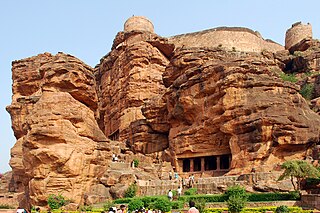
Badami, formerly known as Vatapi, is a town and headquarters of a taluk by the same name, in the Bagalkot district of Karnataka, India. It was the regal capital of the Badami Chalukyas from AD 540 to 757. It is famous for its rock cut structural temples. It is located in a ravine at the foot of a rugged, red sandstone outcrop that surrounds Agastya lake. Badami has been selected as one of the heritage cities for HRIDAY - Heritage City Development and Augmentation Yojana scheme of Government of India.

Mauretania Caesariensis was a Roman province located in what is now Algeria in the Maghreb. The full name refers to its capital Caesarea Mauretaniae, in order to distinguish it from neighboring Mauretania Tingitana, which was ruled from Tingis.

Aigai, also Aigaiai was an ancient Greek, later Roman, city and bishopric in Aeolis. Aegae is mentioned by both Herodotus and Strabo as being a member of the Aeolian dodecapolis. It was also an important sanctuary of Apollo. Aigai had its brightest period under the Attalid dynasty, which ruled from nearby Pergamon in the 3rd and 2nd century BC.
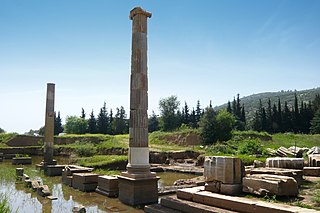
Claros was an ancient Greek sanctuary on the coast of Ionia. It contained a temple and oracle of Apollo, honored here as Apollo Clarius. It was located on the territory of Colophon, one of the twelve Ionic cities, twelve kilometers to the north. The coastal city Notion lay two kilometers to the south. The ruins of the sanctuary are now found north of the modern town Ahmetbeyli in the Menderes district of Izmir Province, Turkey.

Souk Ahras is a municipality in Algeria. It is the capital of Souk Ahras Province. The Numidian city of Thagaste, on whose ruins Souk Ahras was built, was the birthplace of Augustine of Hippo and a center of Berber culture. It was a city of great culture, described as the very hub of civilization.

Tunisia's A1 or A-1 motorway is a 247 km road connecting Tunis and Sfax. In the map shown, the A-1 is in red. The highway was built from Tunis at the north end toward the south and is continuing to be extended.

Colonia Ulpia Traiana Augusta Dacica Sarmizegetusa was the capital and the largest city of Roman Dacia, later named Ulpia Traiana Sarmizegetusa after the former Dacian capital, located some 40 km away. Built on the ground of a camp of the Fifth Macedonian Legion, the city was settled by veterans of the Dacian wars. From the very beginning it received the title of colonia and the status of ius Italicum. With an area of 30 hectares, a population between 20,000 and 25,000, and strong fortifications, Ulpia Traiana was the political, administrative and religious centre of Roman Dacia in the 2nd and 3rd centuries.

Somâa is a town and commune in the Nabeul Governorate, Tunisia. As of 2004 it had a population of 6,287.

Thamusida was a Berber, Carthaginian, and Roman river port that was near the present-day towns of Kénitra and Mehdia in Morocco. Under the Roman Empire, it formed a northern part of the province of Mauretania Tingitana.

Micia was a large Roman fort for auxiliary troops and an important part of the western Dacian limes. The archaeological site is located near the municipality of Vețel (Witzel), Hunedoara county in Transylvania, Romania. This Roman garrison monitored and secured the road and the river route to Partiscum, today Szeged, Hungary. In addition, there was a strategically important river port. In the civil settlement, there were large baths and a small amphitheater. The large number of ancient inscriptions are significant.
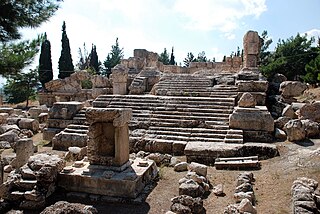
Qasr el Banat is an ancient temple situated 1.5 kilometres (0.93 mi) east of Chlifa in the Baalbek District of the Beqaa Governorate in the city of Qsarnaba (Lebanon).
Vagal or Vagalitanus was a Vandal and Roman era civitas (town) in Mauretania Caesariensis, Roman North Africa. The town has been tentatively identified with Sidi ben Thiour on the Mekerra River near its confluence with the Sly River.(36.073819n, 1.094881e) Nearby towns included Castellum Tingitanum and Catabum Castra (Djidioua). The mines at Malakoff were to the north-east of the town.
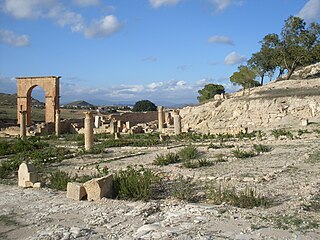
Pheradi Majius is a locality and archaeological site in Tunisia located at 36.250003°N 10.397047°E near the modern town of Sidi Khalifa in Sousse Governorate, Tunisia that is located at 36° 14′ 58″ N, 10° 23′ 57″E.
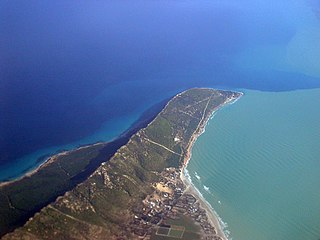
Cape Farina is a headland in Bizerte Governorate, Tunisia. It forms the northwestern end of the Gulf of Tunis. The Tunisian towns of Ghar el-Melh, Rafraf, Lahmeri, and the beach of Plage Sidi Ali Mekki Est are located along the peninsula.

Sidi Said, Morocco is a hamlet in Morocco located at 28° 27' 36" North, 10° 34' 12" was during the Roman Empire one of five Castra (fort) that guarded the city of Volubilis from incursion over the nearby Limes Africanus. Sidi Said was the base for the Cohors IV Gallorum equitata, an auxiliary cavalry unit from Gaul. Rome's control over the area ended, however, following the chaos of the Crisis of the Third Century, when the empire nearly disintegrated as a series of generals seized and lost power through civil wars, palace coups and assassinations.

Castra Severiana was an ancient Roman-era town of the Roman province of Mauretania Caesariensis, in North Africa during late antiquity.



